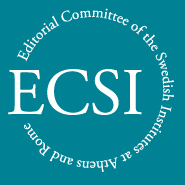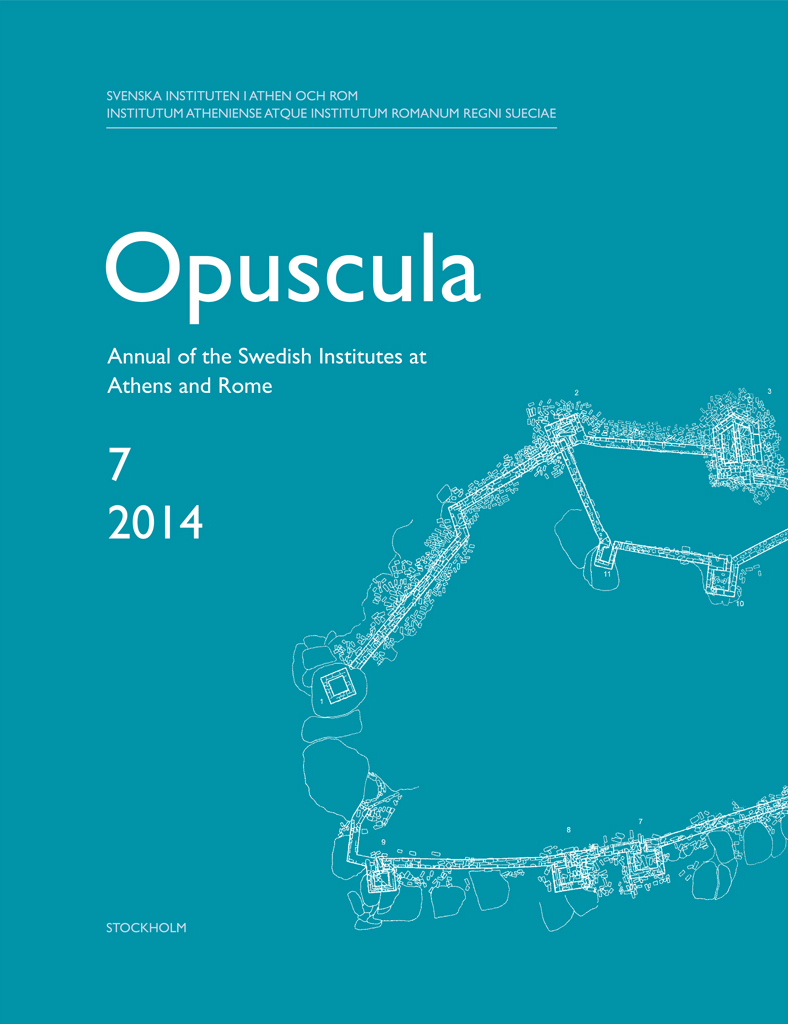Opuscula is published by the Swedish Institutes at Athens and Rome, with the aid of a grant from the Swedish Research Council. Distributed by Eddy.se AB. View journal at ERIH PLUS. All content available with open access. A note on domestic vs communal grain storage in the Early Helladic period By Monica Nilsson Abstract This paper sets out to propose an alternative model of economic management at settlements of Early Helladic I–II date, where evidence of socioeconomic hierarchies is not prominent in the archaeological material. It is suggested here that the remains of certain original structures within the boundaries of settlements were once granaries which served the whole community. If this reading of the material is accepted, then communal storage seems to have supplemented domestic storage or constituted the sole method of grain keeping at a number of settlements during the initial stages of the EH period. The practice was then abandoned and, with one exception, after the EH II–III break there is instead a strong case for domestic storage only. A potential EH I–II communal management of basic food supplies thus carries wider implications for the interpretation of the general management of settlements. Bibliographical information Monica Nilsson, ‘A note…
Opuscula is published by the Swedish Institutes at Athens and Rome, with the aid of a grant from the Swedish Research Council. Distributed by Eddy.se AB. View journal at ERIH PLUS. All content available with open access. Dairy Queen. Churns and milk products in the Aegean Bronze Age By Sarah P. Morris Abstract This article assembles examples of an unusual vessel found in domestic contexts of the Early Bronze Age around the Aegean and in the Eastern Mediterranean. Identified as a “barrel vessel” by the excavators of Troy, Lesbos (Thermi), Lemnos (Poliochni), and various sites in the Chalkidike, the shape finds its best parallels in containers identified as churns in the Chalcolithic Levant, and related vessels from the Eneolithic Balkans. Levantine parallels also exist in miniature form, as in the Aegean at Troy, Thermi, and Poliochni, and appear as part of votive figures in the Near East. My interpretation of their use and development will consider how they compare to similar shapes in the archaeological record, especially in Aegean prehistory, and what possible transregional relationships they may express along with their specific function as household processing vessels for dairy products during the third millennium BC. Bibliographical information Sarah P. Morris,…
Opuscula is published by the Swedish Institutes at Athens and Rome, with the aid of a grant from the Swedish Research Council. Distributed by Eddy.se AB. View journal at ERIH PLUS. All content available with open access. Karpophoroi deities and the Attic cult of Ge. Notes on IG II2 4758 By Jenny Wallensten Abstract Karpophoros, fruit-bearing, is an epithet easily considered as “literary”, i.e., a poetic name with little or no relation to cult. The epigraphic sources, however, clearly show us that gods thus named were offered divine worship. The epithet is found in connection with several deities. Goddesses of agriculture, such as Demeter, and Ge, the Earth, naturally carry this name, but so do Zeus, Dionysos and a goddess known as “The Aiolian”, who was sometimes associated with Agrippina. This paper surveys deities known as karpophoroi and examines what their cult entailed. Its focus is, however, on a brief Acropolis inscription, IG II2 4758, where Ge is honoured as Karpophoros, in accordance with an oracle. The case study provides insights into the Attic cult of Ge, the epithet Karpophoros, as well as the use and function of epithets within Greek dedicatory language. Bibliographical information Jenny Wallensten, ‘Karpophoroi deities and…
Opuscula is published by the Swedish Institutes at Athens and Rome, with the aid of a grant from the Swedish Research Council. Distributed by Eddy.se AB. View journal at ERIH PLUS. All content available with open access. New inscriptions in the Bodrum Museum. A Hellenistic foundation from the area of Mylasa By Signe Isager Abstract This article presents two hitherto unknown Hellenistic inscriptions, both of which are fragmentary. They are inscribed on two sides of a stone which is now in the Museum of Underwater Archaeology in Bodrum (inv. no. 6651) but probably originated from the area of Mylasa. Both inscriptions concern a private foundation that is referred to as the syngeneia in inscription A. The foundation seems to be of a type already known from Halikarnassos, Kos and Thera, for example. This article aims to make the two inscriptions available not least to the many scholars studying associations and foundations. Bibliographical information Signe Isager, ‘New inscriptions in the Bodrum Museum. A Hellenistic foundation from the area of Mylasa’, Opuscula. Annual of the Swedish Institutes at Athens and Rome (OpAthRom) 7, Stockholm 2014, 185–192. ISSN: 2000-0898. ISBN: 978-91-977798-6-9. Softcover, 257 pages. https://doi.org/10.30549/opathrom-07-10 See also Conference: Berit Wells in memoriam
Opuscula is published by the Swedish Institutes at Athens and Rome, with the aid of a grant from the Swedish Research Council. Distributed by Eddy.se AB. View journal at ERIH PLUS. All content available with open access. Cooking stands and braziers in Greek sanctuaries By Charlotte Scheffer Abstract The presence of dining-rooms in Greek sanctuaries shows that food was eaten and most likely also cooked on the premises. The study of both the preparation and the cooking of the food eaten in the sanctuaries would be too much, and this paper will therefore concentrate on the presence of cooking stands and braziers in Greek sanctuaries, their uses, and on other related means of carrying the pots. Cooking stands were meant to hold the cooking pots above the fire; they were open at the bottom and were placed in the fire or perhaps rather in the glowing embers of a fire. In Etruria, there were three types (types I–III): a cylindrical stand with a top plate with holes, a half-cylindrical stand with three supports attached to the inner side of the wall, and a barrel-like stand with a narrower top. Cooking braziers had, unlike the cooking stands, a closed bottom as…
Opuscula is published by the Swedish Institutes at Athens and Rome, with the aid of a grant from the Swedish Research Council. Distributed by Eddy.se AB. View journal at ERIH PLUS. All content available with open access. Castration, cult and agriculture. Perspectives on Greek animal sacrifice By Gunnel Ekroth Abstract The castration of most male animals seems to have been the rule in ancient Greece when rearing cattle, sheep, goats, and pigs; only very few adult males are needed for breeding purposes and flocks of bulls, rams, billy-goats and boars are difficult to keep, since they are too aggressive. Castrated males yield more and fattier meat, and, in the case of sheep, more wool. Still, sacred laws and sacrificial calendars stipulate the sacrifice of uncastrated victims, and vase-paintings frequently represent bulls, rams and billy-goats in ritual contexts. This paper will discuss the role of uncastrated male animals in Greek cult in the Archaic, Classical and Hellenistic periods, both from a religious and an agricultural perspective. Of particular interest are the relations between the practical, economic reality and the theological perception of sacrifice. These issues will be explored using epigraphical, literary, iconographical and zooarchaeological evidence. Bibliographical information Gunnel Ekroth, ‘Cult, castration…
Opuscula is published by the Swedish Institutes at Athens and Rome, with the aid of a grant from the Swedish Research Council. Distributed by Eddy.se AB. View journal at ERIH PLUS. All content available with open access. Berit Wells in Memoriam By Arto Penttinen & Jenny Wallensten Introduction The following section honours our colleague, teacher, and friend, Berit Wells. The contributions were originally to be included in a Festschrift, which we wished to present to Berit on her 67th birthday. Sadly, Berit lost her battle against cancer before we could finish the volume. We thus decided to transform the Festschrift into a conference dedicated to her memory, and this event took place over two cold winter days in December 2009. For the Festschrift we had chosen two themes: religion and food production in the ancient Greek world. The interface of these very broad themes seemed to us to converge and offer an overall perspective of Berit’s research and simultaneously, they allowed colleagues from all stages of Berit’s careers to take part and contribute to the conference. The six articles included in Opuscula 2014 are a selection of the conference papers, which also included reports from the Poros excavations. Poros was…
Opuscula is published by the Swedish Institutes at Athens and Rome, with the aid of a grant from the Swedish Research Council. Distributed by Eddy.se AB. View journal at ERIH PLUS. All content available with open access. The Swedish Jordan Expedition 2013 at Tall Abu al-Kharaz. Preliminary results from Areas 9, 10 and 11 By Peter M. Fischer & Teresa Bürge Abstract The Swedish excavations at Tall Abu al-Kharaz, a twelve-hectare tell in the central Jordan Valley, continued in 2013 in order to shed further light on the Iron Age occupation of this city that was first settled around 3200 BC, corresponding to the conventional Early Bronze Age IB. The Iron Age occupation lasted from the 12th century BC until 732 BC, when the city was conquered by the Neo-Assyrians. From 2009 to 2012, excavations in Area 9 revealed an exceptionally well-preserved two-storey compound dating from Iron Age I (local Phase IX), i.e. around 1100 BC. The stone compound was exposed for a length of 46 m. It consists of 21 rooms, with walls still standing to a height of more than 2 m. Several hundred complete vessels and other objects point to the extensive contacts of a fairly rich…
Opuscula is published by the Swedish Institutes at Athens and Rome, with the aid of a grant from the Swedish Research Council. Distributed by Eddy.se AB. View journal at ERIH PLUS. All content available with open access. The solidus hoard of Casa delle Vestali in context By Svante Fischer Abstract In this paper, I discuss the context of a Late Roman solidus hoard found in the Casa delle Vestali on the Forum Romanum in Rome. The hoard consists of 397 solidi, Late Roman gold coins. Most of the hoard consists of uncirculated solidi struck in the name of the Western Roman emperor Procopius Anthemius (AD 467–472). By means of situating the hoard within the context of the reign of Anthemius and the collapse of the Western Roman Empire, the aim of this paper is to determine if the coins in the Vestal hoard can be related to other contemporary coin hoards by means of numismatic typology; this information could add to our understanding of why Anthemius’ reign is considered such an unmitigated failure and why the Empire collapsed soon after his murder. In this article, the composition of the hoard is examined, and the contents are compared to other contemporary…
Opuscula is published by the Swedish Institutes at Athens and Rome, with the aid of a grant from the Swedish Research Council. Distributed by Eddy.se AB. View journal at ERIH PLUS. All content available with open access. The New Swedish Cyprus Expedition 2013. Excavations at Hala Sultan Tekke. Preliminary results. By Peter M. Fischer & Teresa Bürge. With contributions by R. Árnadóttir, M. Mehofer, F. Köstelbauer, A. Satraki, L. Mazzotta, A. Trecarichi, D. Blattner, B. Stolle, & A. Miltiadous Johansson Abstract The results from a 1.3-hectare GPR survey in 2012 were confirmed during the 2013 excavation of a limited area (200 m2). Three phases of occupation were partly exposed. The most recent phase, Stratum 1, contained living and working facilities, e.g. for spinning, weaving and purple dyeing. Textile production also took place in the older Stratum 2, where the major activity was metal-working: 300 kg of remains from copperworking consist of tapped slag, furnace walls, fragments of at least five tuyères, crucible fragments, copper/bronze fragments and pieces of raw copper. Another of these unique kraters of White Painted Wheel-made Pictorial Style (WPPS) was found. It was termed “Horned God Krater” on account of one of the decorative elements. These kraters…

